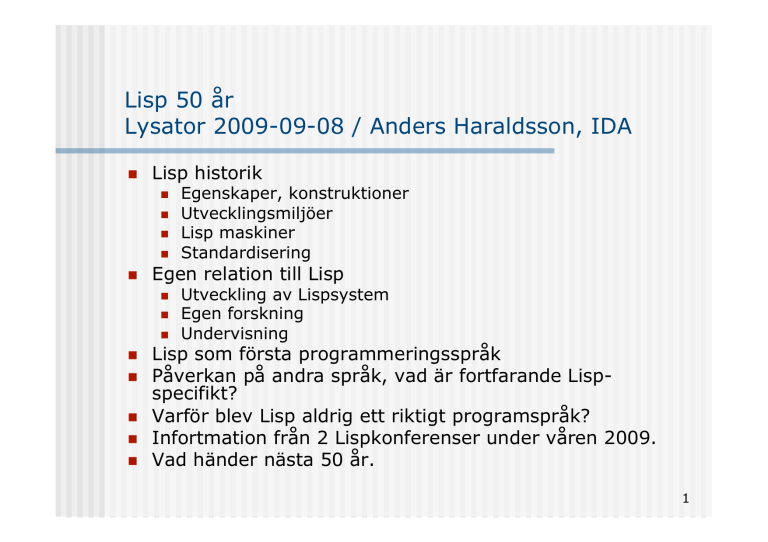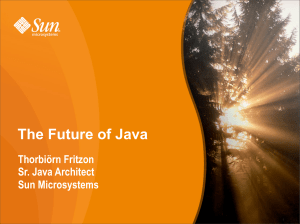
Lisp 50 år
Lysator 2009-09-08 / Anders Haraldsson, IDA
Lisp historik
Egen relation till Lisp
Egenskaper, konstruktioner
Utvecklingsmiljöer
Lisp maskiner
Standardisering
Utveckling av Lispsystem
Egen forskning
Undervisning
Lisp som första programmeringsspråk
Påverkan på andra språk, vad är fortfarande Lispspecifikt?
Varför blev Lisp aldrig ett riktigt programspråk?
Infortmation från 2 Lispkonferenser under våren 2009.
Vad händer nästa 50 år.
1
Egen tidig relation till Lisp
1968. Gick Lispkurs för Erik Sandewall i Uppsala.
1969. Gjorde 3-betygsarbete (C-uppsats). Ett
program om släktskapsrelationer i Lisp.
1970. Höll min första Lispkurs, och har ännu inte
hållit min sista.
1974. Skrev min första Lisp-kompendium / bok.
1970-1974, Implementering av Lisp-system
1971-1977, Forskning och doktorsexamen. A
program manipulation sysem based on partial
evaluation. (Första i datalogi och nr 14 på LiTH)
2
Egen tidig relation till Lisp
1969. Forskningsgruppen Datalogilaboratortiet skapades vid
Uppsala universitet
Lisp-utveckling och AI-forskning
CD 3600 (Jan Kent)
Siemens (Jaak Urmi, Haraldsson mfl)
IBM 360/370 (Jaak Urmi, Mats Andersson, Jim Goodwin mfl)
Fortran Lisp (Mats Nordström)
PL 360 / Lisp (Tore Risch)
QLISP (Rene Reboh, Haraldsson)
1976 Större delen av gruppen flyttade till Linköping där Erik
Sandewall blev professor.
Sandewall, Haraldsson, Olle Willen, Sture Hägglund, Pär
Emanuelsson, Östen Oskarsson, Jerker Wilander, Mats Andersson,
Jaak Urmi, Erik Tengvald, Jim Goodwin, senare Tore Risch m fl?
3
A historical view Lisp
McCarthy 1959
Två huvudsakliga utvecklingslinjer:
Lisp1.5 -> BBN-Lisp -> Interlisp -> Medley (Lisp maskiner) ->
Cvommon Lisp
Lisp 1.5 -> MacLisp > Scheme -> Symbolics/LMI (Lisp maskiner) ->
Common Lisp
Sandewalls Lisp experience paper, Computing Suvey 1977
Förklarar Lisp-communitin för den mer ”konventionella” språkvärden.
4
John McCarthy – design considerations for Lisp 1.5
(CACM April 1960)
The system was designed to facilitate experiments with a
proposed system called Advice Taker, whereby a machine could
instructed to handle declarative as well as imperative sentences
and could exhibit ”common sense” in carrying out its instructions.
... be based on a scheme for representing partial recursive
functions of a certain class of symbolic expressions. (Sexpressions)
… this formalism has advantages both as a programming language
and as a vehicle for developing a theory of computation.
… the universal S-function apply which plays the theoretical role of
a universal Turing machine and the practical role of an interpreter.
… representation of S-expressions in the memory … by list
structures … and the representation of S-functions as programs
5
Lisp - concepts
partial functions – programs may not terminate
conditional expression (p1 -> e1, … , pn -> en)
recursive functions
n! = (n = 0 -> 0, T -> n * (n – 1)!)
notation for functions and forms – lambda-expressions (Church)
λ((x, y), y2+x)
S-expressions ordered pair (A . (B . C))
a list can be represented as an S-expression
the list (A B) is represented by (A . (B . NIL))
functions of S-expressions in meta notation
cons[(A . B); x]
functions represented as S-expressions (program-data
equivalence)
the universal S-function apply, takes an S-function f as an Sexpression and an argument list of S-expressions, and the evalfunction taking a form and an association list with variables and
values (expressions?).
6
Lisp concepts
functions with functions as arguments (higher order
functions)
Implementation on IBM 704. Lists represents with
computer word and addresses,
… the left box of a rectangle represents the address field
of the word … and the right box …. the decrement field of
the word. Gave CAR (Contents of Address Register) and
CDR (Contents of Decrement Register)!
free storage list (15.000 cons-cells in IBM 704), automatic
garbage collection
Top lopp with EVALQUOTE (more or less APPLY)
APPEND ((A B C) (X Y)) same as
(APPEND (QUOTE (A B C)) (QUOTE (X Y)))
7
Lisp development –> BBN -> Xerox-> INTERLISP > Medley
Warren Teitelman, Ph D thesis 1966 introduces programming
tools:
spelling corrections
breakpoints, advice (change interface to function, trace)
DWIM (DO What I Mean), corrected errors, unbound atoms,
undefined functions etc
structure editing on memory resident list structure
file package med “cleanup”
CLISP (Conversational Lisp), could write
(IF N=0 THEN 1 ELSE N*(FAC N-1))
used DWIM (as errors, N=0 was unbound atom!)
corrected: (IFFN=0 THENN 1 ELSE N*8FACN-1)
Masterscope (program analysis – function calls, functions used
destructive operations, etc , editing)
8
Lisp development –> BBN -> Xerox-> INTERLISP > Medley (cont.)
Implemented PDP10 (first QZ Sthlm computer center),
DEC20 (used in Lkp both education and research), Xerox
Lisp machines/Danderlion/Medley
Datalogilaboratoriet implemented
a FORTRAN-versiron of LISP (Mats Nordström),
parts of INTERLISP on a small Siemens 305 (Urmi,
Haraldsson)
full INTERLISP on IBM 360 / Siemens (Jaak Urmi,
Mats Andersson among others)
9
Lisp development –> BBN -> Xerox->
INTERLISP -> Medley (cont.)
Language features:
LAMBDA as now, NLAMBDA did not evaluated its
argument. (Did not used macros). Use eval for those
arguments which should be evaluated.
An implementation of (FOR I = 1 TO N (PRINT I))
(NLAMBDA (VAR X START-EXPR Y END-EXPR FOR-BODY)
(SET VAR (EVAL START-EXPR))
… go on looping …)
10
Lisp development –> BBN -> Xerox->
INTERLISP -> Medley (cont.)
Lexical closures, FUNARG-expressions produced by using
FUNCTION. Introduces spaghetti stack. (Bobrow)
Environment, stacks, was reachable from the language
(STKPOS, RETFROM)
Dynamic binding with “shallow binding techniques”.
Common Lisp / Medley came with static binding. Was
implemented on top of INTERLISP
Lisp machines introduced graphical environments.
Xerox -> Envos -> Venue (out of business)
11
Lisp development –> MacLisp – Lisp
machines, new Lisp dialect: Scheme
Macros for introducing special forms (mid 60)
Errorhandling (ERRSET), CATCH och THROW (1972)
Big numbers, arbitrary precision (1971)
Read tables –programmable syntax
MIT Lisp Machine project (1974) (Grenblatt, Stallman,
Moon) –LMI (Lisp Machine Inc), Symbolics
12
Lisp Machines
Von Neuman architecture not good for Lisp
First ideas Deutsch (1973)
“a singel-user minicomputer-calss machine that would be
specially microcoded to run lisp and support a Lisp
development environment.”
cdr-coding
Micro coded, incremental and generational (ephemeral)
garbage collection
13
Scheme
MIT Sussman, Steele, 1975
Actually implemented to understand Hewitt’s actor model.
They needed continuations and introduced static binding.
Actors and lexical closures were the same concept.
Lambda: The ultimate Imperative (Steele 1976)
demonstrated how a number of control structures could be
implemented in Scheme
Tail recursion
Scheme -> T; compilation through source-to-source
transformation to continuation-passing style (CPS)
14
Common Lisp
Two directions INTERLISP and MacLisp.
1981 an attempt to get them together.
1984 Common Lisp the language.
Development of object orientation
flavors
CLOS (Common Lisp Object Oriented System)
multiple inheritance, mixins, generic functions,
method combination, metaclasses, meta-objects,
user customization of instance creation,
change class etc
15
Main features of Lisp
Programs as data structures
Programs are abstract syntax trees, no parsing
Procedures as first order objects, closures
Extendible language, the macro facility
Interpreted and incremental
Style of programming
Sandewalls (1977) The Lisp Experience in Computing Survey
the first paper explaining Lisp outside the Lisp/AI- community
16
Concepts in programming languages – a historical view
AI-languages
Planner, QLISP
Pattern matching
Backtracking
Logikprogrammering / Prolog
17
My own research: Concepts and methods (1971-1974)
Non-determinism, continuations
PCDB Predicate Calculus Data Base (IFIP 1974)
Coompilation of predicate formulas (Horn clauses) to Lisp-programs
(mor or less compilatoion of logic programs (Prolog) to Lisp
remainder procedure (today continuations) with funargexpressions (closures)
18
My own research: Concepts and methods
Closures, partial evaluation
Partial evaluering
REDFUN
Relation interpretation and compilation
Self application (Futamuras projections)
Generating compiler from interpreter
Compiler-compilers
State of the art today
19
Python
“Basically, Python can be seen as a dialect of Lisp with
"traditional" syntax (what Lisp people call "infix" or "m-lisp"
syntax). Python supports all of Lisp's essential features except
macros, and you don't miss macros all that much because it
does have eval, and operator overloading, and regular expression
parsing, so you can create custom languages that way.” (
http://norvig.com/python-lisp.html 2009-09-07)
Interaktiv REPL (Read Eval Print Loop)
Objekten är typade, ej variablerna
Har symboler
Inbyggda listor
Dictionaries (nyckel-värdepar)
Funktioner – lambdauttryck
Closure
Iteratorer, generatorer
Anrop till interpretator med eval/apply/exec
20
21
Ruby
I
stort som Python
Block/kod
– kan kan överföras som
parametrar
22
C++
Ny
standard C++0x (se wikipedia)
C++
kommer innehålla lambdauttryck
[](int x, int y) {return x+y}
Någon
form av closure
23
Egna reflektioner
Does
syntax matter?
Kan man inte programmera/editera direkt i det
abstrakta syntaxträdet, dvs strukturen.
Programstrukturen kan visualiseras på andra sätt.
Textuell syntax kan vara bra både som inmatning
och för läsbarhet till resp från syntaxträdet.
Medley / Lispmaskinerna hade struktureditor.
Textfil skapades för lagring av program och för
snygg utskrift (jfr publiceringsnotation Algol)
24
Egna reflektioner
Det
enda som Lisp verkar ha kvar är
att programmen representeras i
manipulerbar datastruktur, vilket
enkel möjliggör makros, advicing
och programtransformationer.
Finns det inga andra språk med
samma modell?
25
The macro debate
Det
pågår en debatt om
användningen av makro
Kunna
skapa ett mer domänspecifikt
språk
Komplicerar förståelsen
Hygieniska makros
26
Lisp som första
programmeringsspråk i
undervisningen
D
och C har haft Lisp sedan mitten
av 80-talet.
Y har haft Scheme sedan mitten av
90-talet.
Modell: Börja med funktionell
programmering.
Har det vara bra? Är det fortfarande
bra? Skall det vara så i framtiden?
27
Varför blev Lisp aldrig ett ”riktigt”
programmeringsspråk?
Före sin tid?
Annorlunda syntaxen, parenteserna?
Man skriver rekursiva program?
Mappningen mot hårdvara?
Inkrementella, dynamiska, snabbhet?
Många system innehåller någon typ av
gömd Lisp, men man vågar inte riktigt tala
om det.
28
Lisp nästa 50 år
Det är svårt att skapa en community för ett gammalt
språk. Inget problem med “nya” Lisp-dialekter (om man
får kalla dessa detta) som Python och Ruby.
Några starka Lisp-utvecklare av produkter: Allegro,
LispWorks
Common Lisp, som standard, är för klumpig. Skall man
dra igång en ny standardisering?
Det enda “nya” språket man talar om, som skulle kunna ta
över är Clojure (Rick Hickey)
29
Lisp nästa 50 år – Clojure?
Clojure is a dynamic programming language that
targets the Java Virtual Machine. It is designed to be
a general-purpose language, combining the
approachability and interactive development of a
scripting language with an efficient and robust
infrastructure for multithreaded programming.
Clojure is a compiled language - it compiles directly
to JVM bytecode, yet remains completely dynamic.
Every feature supported by Clojure is supported at
runtime. Clojure provides easy access to the Java
frameworks, with optional type hints and type
inference, to ensure that calls to Java can avoid
reflection.
30
Lisp nästa 50 år – Clojure?
Clojure is a dialect of Lisp, and shares with Lisp
the code-as-data philosophy and a powerful
macro system. Clojure is predominantly a
functional programming language, and features
a rich set of immutable, persistent data
structures. When mutable state is needed,
Clojure offers a software transactional memory
system and reactive Agent system that ensure
clean, correct, multithreaded designs.
31













